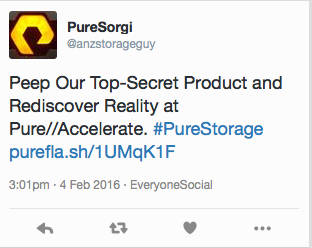This article is more than 1 year old
Pure as the driven CEO: El Reg chats to Scott Dietzen on taking the flash array high road
Pure Pods and yes-we-can-ery
Scale-out
Dietzen said Pure's original product technology design was built to be able to support scale-out. At present: "We're delivering phenomena, performance and hitting customers' scale targets without going outside the frame. We can deliver 300,000 32K IOPS, generally equivalent to XtremIO's 1.2 million 8K IOPS and at a half petabyte capacity XtremIO needs six times the CPU and DRAM to get to Pure's level of performance."
He sees customers needing petabytes in a single frame in the object and file markets, but he doesn't see the need for a 2PB frame in the block storage market.
Scale-out designs in block storage are not as efficient in terms of hardware and don't support Pure's Evergreen business model. He notes that a 10TB XtremIO X-brick is not compatible with the 20TB one or with the 40TB one and Dietzen says this is not right for customers.
With Pure's Evergreen business model, customers can independently upgrade their array's capacity, performance, density, connectivity and software.
"We want to independently scale performance and capacity, and we're in a position to deliver that. It puts the customer in a much better place than current scale-out designs. Evergreen has been so powerful it would be a tad silly for us to launch a new product without having figured out how to use Evergreen."
Roadmap principles
Dietzen enunciated several principles underlying Pure's roadmap. First, the key to the storage market is software. Then Pure's hardware is built to support flash and the Evergreen model. A third point is that cloud automation is absolutely crucial, with a mention that Pure's automated analytics result in 80 per cent of support calls being Pure telling its customers about a potential problem before the customers are aware of it.
Evergreen was pushed as the fourth principle: "The perpetual state of storage migrations needs to end. None of the incumbents are close to cracking these four things. That's why we have such high customer satisfaction levels."
Cloudy flash future
Pure has an event in March, Pure Accelerate in San Francisco, at which more details about its future intentions will become clearer, with topics such as:
- Shrinking Time to Value With a Self-Service Cloud.
- Can Private Clouds Be More Economical Than Amazon Web Services?
- "Right-Cloud" your workloads: Public, Private, Hybrid and *aaS Cloud Models.
- Pure Storage Flash Futures.
- Evergreen Storage & Beyond.
It looks like Pure's future is cloudy and includes faster flash.

Teasing new product tweet about Pure Accelerate event
Dietzen is riding high. Pure is the only stand-alone all-flash array startup riding high, up there with the leading incumbents. SolidFire is now a NetApp business and wasn't as big a business revenue-wise as Pure. Kaminario is a long way behind, looking forward to becoming a $100m/year business.
Tegile and Tintri have both entered the AFA business but are behind Pure in revenues. Nimble Storage is sure to follow them. Its current, hybrid array-only revenues are around $80m/quarter, compared to Pure's $130m/quarter.
If Pure can keep itself in the technological forefront and use that and Evergreen to grow fast, and then transition from investing all revenues into growing the business to making a profit, without suffering a Nimble Storage-style upset, as well as growing the business – then he will ride even higher. ®
